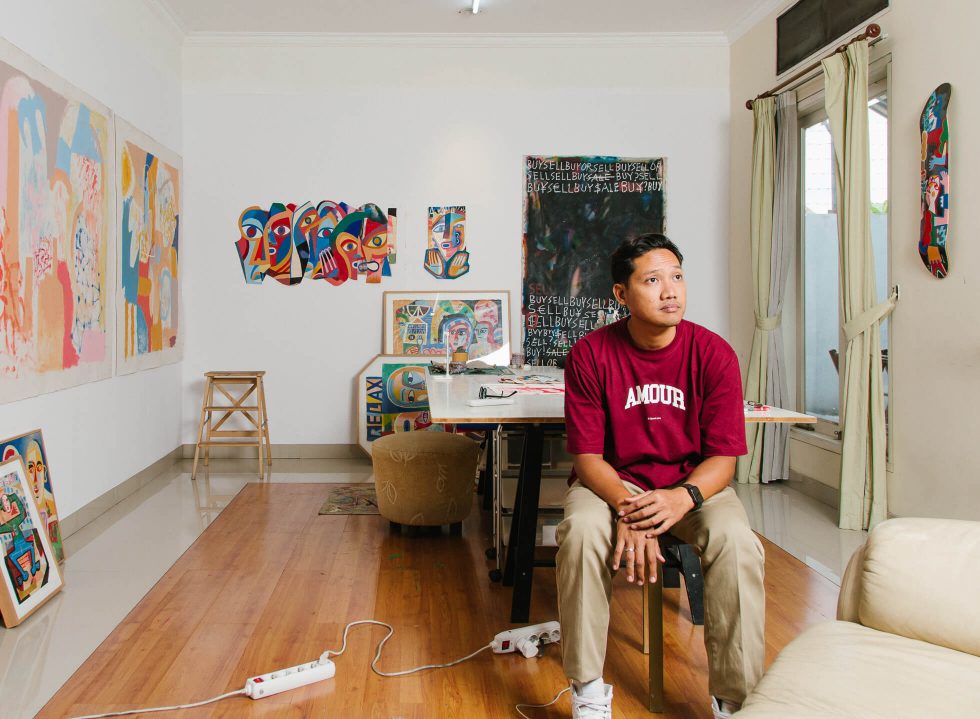Artists in Dialogue is a series of articles where we bring together two creatives from different backgrounds to share what it’s like to navigate the creative industry and exchange insights on their practices.
Abenk Alter and Isha Hening are names that are not foreign to the art scene. Abenk is an illustrator and painter well known for his distinct geometric shapes and block colours, with paintings and murals exhibited in galleries across the country. While Isha is a multi-disciplinary artist specialising in motion graphics; between high profile musicians and international brands and exhibitions, the artist is familiar with large-scale projects, showcasing her signature style of psychedelic and playfully abstract shapes.
The two creatives and longtime friends meet over Zoom, where they talk about identity, managing time, drawing boundary lines when it’s needed, and the shift towards digital art and NFT.
Isha Hening (IH): Hi Abenk! So when did you actually start your career in the creative industry?
Abenk Alter (AA): It actually all started with music. You could say that I seriously got into it around the same time I got my recording deal with my band at the time, Soulvibe, and we released our first album. So I would say it was sometime between 2004 and 2005. What about you?
IH: For me, I would say it was around 2007? I went to Institut Teknologi Bandung for visual design, and I was working on a lot of video edits. But because we had little budget then, I was forced to learn other skills, and that’s how I started learning motion graphics and it grew on me until today. I’m interested in your transition from music to painting though, what was that like for you?
AA: To be honest with you, there were a lot of considerations and internal conflicts. It wasn’t easy, because it meant that I would kind of have to start again from the bottom and prove that I’m serious about it [painting]. But drawing has always felt second nature to me. I’ve always wanted to draw when I was younger and my mother was very supportive of that. Although I was very happy being in the studio and doing music, I couldn’t resist the urge to return to it.
IH: On a scale of 1-10, how difficult was your transition from music to painting?
AA: (laughs) Probably 100! Especially because at that time I already had a family, so the idea of starting from 0, there’s definitely more to consider and risks involved.
IH: Speaking of family, what is it like juggling your time between them and work?
AA: I’m generally not one to plan ahead in terms of painting. I prefer for it to be a little spontaneous… But this doesn’t really work when you have a family. It was the pandemic actually that made me realise that I needed to divide my time better. And sometimes, this means compromising on my idealism and ego, while being more disciplined with my time and energy so I can work more efficiently. When we were all stuck at home, it was a little chaotic when I didn’t divide my time well.
IH: I can really relate. I think this is still something I constantly struggle with: balancing my personal and professional life. Sometimes, my life feels very one-sided. So often my energy and thoughts are spent on work that I don’t really have time for others. I feel guilty a lot, about not being able to meet my friends or family when I want.
AA: I feel you! But you know what they say, “If you don’t master your time, you will be enslaved by your time,” so I guess we have to learn to master our time. But what about you, how has the pandemic shifted your methods of working?
IH: Mmm, I think the pandemic really afforded me the time to re-evaluate my method of working. Prior to it, it was one project after another and time just went out the window. There were patterns I noticed that made me stressed and miserable, so in a way, I got to filter through what actually works and what doesn’t. And now, I take more time when taking in projects. I would talk to my producer and we would discuss together if we should take it on or not.
AA: Did it make you more reflective then?
IH: Yeah, it forces you to stop and step back for once. In the midst of a busy schedule, what do you usually do for fun?
AA: I look forward to spending time with my family, my wife and kids. But a personal activity that I really enjoy is cycling and playing golf. What about you?
IH: (laughs) Your hobbies are so healthy. Mine is definitely collecting and building mechanical keyboards! I also really like reading. I take holidays every now and then but for the most part, it’s work work work. But, my fun activities are pretty boring: reading, cooking and playing around with mechanical keyboards. There is something I’m quite curious about, what is it like to work on a more traditional medium of art in a time where the digital seems to be taking over? My father is a painter too, so I really want to know.
AA: I guess to me, it all boils down to preferences. It’s really important to know who you are, what you’re doing and why you’re doing it, so you won’t easily be influenced. But that also doesn’t mean we turn a blind eye to it. In the case of digital technology, I have to accept that they are here to improve our lives. I mean, I use an iPad to sketch because it’s a lot easier. I feel like it’s important to differentiate between adding or completely shifting course when it comes to your craft. Alright, my turn! I guess when we talk about digital we can’t disregard social media and NFT. What’s your take on those two?
IH: (laughs) I feel like the conversation can drag on when we talk about this. But in short, with social media, I feel like there are a lot of opinions thrown around, but in the end, there are things that are ignored like the integrity of the artist and what the person is really like. It’s easy to become biased, say, does supporting an artist mean we can only say good things about them? I don’t think that’s right. It’s dangerous for an artist to have an environment where friends and peers can’t be honest with you. But sometimes it can all feel mushed together—the negative words, critiques, praises. It’s hard to differentiate which ones are real and which ones are not.
AA: That’s true, it’s easy to compare. For me, I always come back to the reasons why. Why do you want to make this? Why do you work on this? Everyone has a perspective, an entry point. And what works on social media doesn’t necessarily mean it’ll work for us.
IH: True! I always thought that technology and social media should be treated like fire and water. There’s a proverb that goes “kecil jadi kawan, besar jadi lawan” or “when they’re small they’re a friend, but as they grow in size they turn into enemies”. Everything needs to be used properly, in a way that’s controlled and not extreme.
AA: Yes, don’t let it control you! Sometimes, we do fall under its spell.
IH: Yeah, and in an age where everything is instant, I think it is easy for people to feel like they’ve succeeded or failed really quickly. It disregards the value of the process. Let’s say today, a lot of people feel like they’ve done a lot when they posted five works, but when the response doesn’t meet their expectations, they instantly feel like a failure. The same goes for the opposite, when people applaud your work, you immediately feel like you’ve succeeded. That’s a challenge I think because as artists, you want to be persistent and consistent. You have to remember you’re not doing it for social media or validation, you’re doing it for yourself.
AA: I completely agree. If I could add a bit, I think it’s also made it more difficult to separate between what you like, what you like to make, and what you can make. Back then, the stream of information wasn’t as dense as it is now. Today, the challenge is how to discover yourself within that stream of information, so that you can still be yourself and your identity is not based on others. That’s the hard part really, discovering yourself in the midst of all this.
IH: I guess in a way, we need to constantly remind ourselves that we are continually evolving. This realisation that you need to grow and know who you really are, but we are still and will continue to grow too. As for NFT, from my observation, the community is pretty solid and very supportive of one another. When it started booming, there was quite a lot of push for me to enter it, especially as a visual artist. But after much consideration, I wanted to make sure that although I’m open to it, I’m not just following a trend. If the timing’s right, I’ll release something, but if not, then I won’t. But I’m happy that my friends can be active in that field though because now, the world of visual arts feels more alive.
AA: With NFT, I see it as a new opportunity. I believe that this medium has a lot of potential because, whether we like it or not, the world is leaning toward digital. What this has meant for me is finding my pace and trying to see if this aligns with my skills. At the moment, I’m working on a few [digital art], but I’ve also recognised that my pace will be different from others in the field. But the newness and possibilities that come with it are exciting. Like now, I’m making music again to complement my visuals and I’m learning a bit about animation. You know I took animation for college, Sha? (laughs)
IH: Really? I didn’t know that!
AA: Yeah, but I skipped class way too much and I regret it. Maybe I need to relearn simple animation techniques with you, I’ll visit your studio sometime (laughs). There’s a lot I still need to explore and learn, but it’s definitely something I’m open to, there’s a lot of cool work out there. And I agree with you, the community is really supportive! Even though I’m still quite hesitant, I just learn and experiment in my own time. What about when it comes to juggling commercial and personal work? How do you find the balance?
IH: I don’t find it difficult necessarily. I like both. Like, I love personal projects because I have more freedom in terms of expression and doing what I want, but commercial projects also make me happy. During my early years, I work a lot with clients, so it’s a lot of problem-solving and making it work for both parties. But through that, I slowly learn my qualities and strengths. Now, I feel like I can make something that is representative of who I am that when people see it, they would say “Oh this is Isha’s”.
AA: That’s interesting. I think with commercial projects, it’s easier to see how we’re directly contributing, whether it’s to translate a narrative or communicate something to a greater audience through the artwork. But it doesn’t mean that personal projects are not important, it’s just a more indirect route. I feel like one feeds off the other. So I learned to create a space where I can freely make art for myself and also make something useful for other people.


















